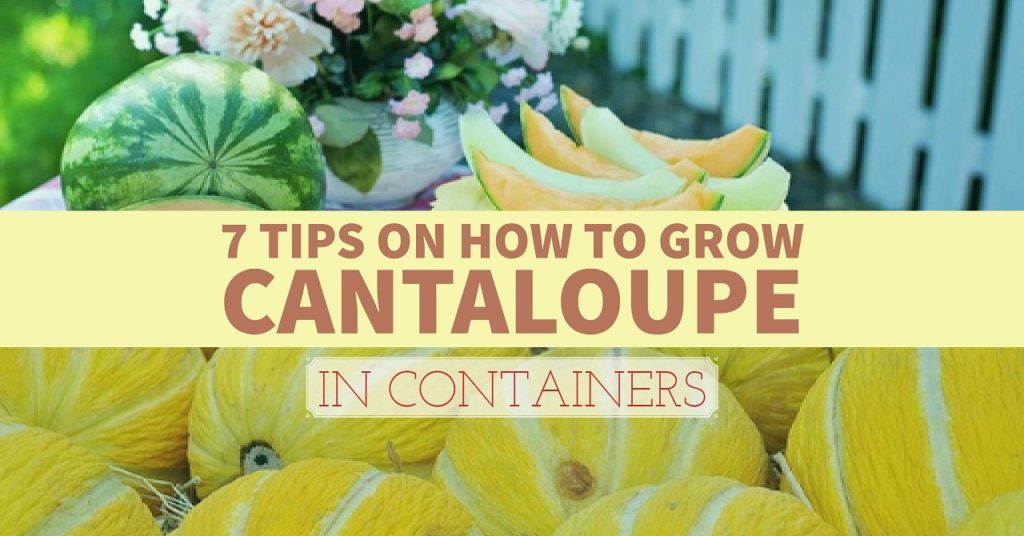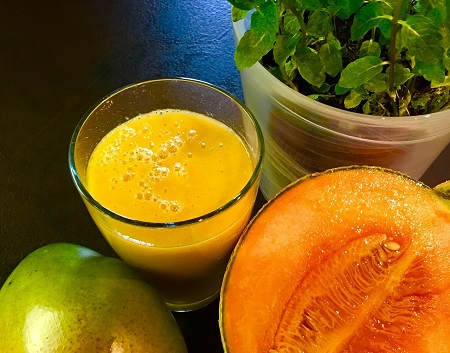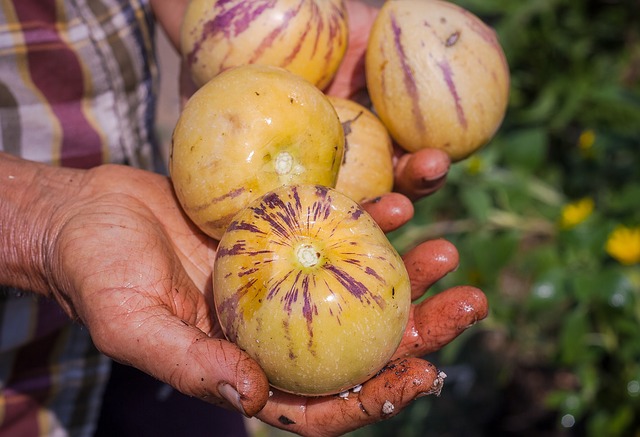Hey! By the way… TheEdibleTerrace is reader-supported. When you buy through links on our site, we may earn an affiliate commission and as an Amazon affiliate, we earn from qualifying purchases. Thanks in advance for your support!

In this ongoing series, we are going to cover how to grow cantaloupe in containers. Who doesn’t love the idea of going right outside one’s door to pick the fruit you are going to eat for the very next meal?!?
How To Start Melon Seeds
First, a little piece of trivia. Cantaloupe are also called muskmelons. That was a new one for me!
[easyazon_infoblock align=”right” identifier=”B00PTLGKSQ” locale=”US” tag=”edibleterrace-20″]I always recommend non-GMO seeds (organic too if you can find them) for growing your edible plants. To start the seeds, you can use the same methods we outlined in our post on how to grow tomatoes or this one on how to start seeds where I experimented with greenhouse seed trays and peat pots. Once the seedlings have grown, you can either transplant them in nutrient rich soil which has been fortified with compost or another organic fertilizer.
If you’re starting your plants from seeds, there are a couple ways to do it:
- You can place the seeds in a damp paper towel. Compost “tea” with water in the cloth will keep the seeds moist and help them sprout. Make sure the towel isn’t too wet before putting the seeds in it. Spread the seeds out, fold the towel and put it gently into a sandwich bag (do not seal the bag).Keep the seeds in a slightly warm area (65F-75F) until they germinate. Keep an eye on the towel to make sure it does not dry out. As soon as the seed breaks and you see new growth, plant it in soil.
OR
- You can place the seeds in individual peat pots or a seed starting tray. The nice thing about peat pots is that when they start to sprout, you can place the seedling, pot and all, into the container of your choice.They will be ready for planting at approximately three or four inches tall. This ensures the roots will take. Water the seedlings when you place them in the soil. Once they start to grow, it’s just a matter of water, food, and vigilance.
Dwarf Melon Varieties
There are actually several dwarf melon varieties that you can choose from for your small space garden. I tell you about a few of them below.
- The Sugar Cube Muskmelon/cantaloupe is only 2 lbs and as indicated by the name quite sweet. Disease resistant. 80 days to harvest.
- The Minnesota Midget is 1-2 lbs (bush type). You can get the Heirloom seeds inexpensively here on Amazon. 60-75 days to harvest.
- Tasty Bites Melons are 1 3/4 to 2 1/2 lbs. These are known for having a tropical twist to their taste. 70-80 days to harvest. Disease tolerant and considered to have a longer than normal shelf-life.
- Alvaro Melons are said to be one of the first melons to mature each season. They grow to 5-inches in diameter. 65 days to harvest.
- Charentais Cantaloupe will grow to the size of a softball. It harvests in 70-80 days. The original strain is from France.
- The Top Mark Cantaloupe by David’s Seeds can grow to 2.5-3.5 lbs. It harvests in 100 days. This is considered a popular commercial variety. Resistant to Powdery Mildew.
Best Time To Plant Melon
Assuming you are not starting your seeds indoors, plant about two weeks after the last average frost date in your area. Put the seeds in the soil one inch deep, cover up, then give them a good water (more on watering below). Check the seed packet for spacing. Be careful about putting too many seeds in your pot. You don’t want to overcrowd your plants.
Farmer’s Almanac will help you figure out your average last frost date here.
If you are starting your seeds inside, plant them 4-5 weeks before your last frost date. This way they will be ready to move outside as soon as the temperature becomes more agreeable.
Grow Cantaloupe In A Pot
You don’t really need a large container to house the cantaloupe plant but you do want one that will hold about 5 gallons of soil.
Growing cantaloupes in pots only requires a tote-sized container, and from there you can decide if you want you want to grow it up or out. A large clay or terra cotta pot, a deep drawer that you’re re-purposing, or maybe a half whiskey barrel would also do the trick.
Make sure the soil you are using has perlite or vermiculite in it. Both of those products keep your soil “holey” so oxygen can flow through it. If you already have the soil but it does not have either of those in it, you can buy it separately and add. I personally use perlite in my soil mixes (also use mushroom compost but that’s for another post!). Amazon does sell an organic version very affordably.
How much perlite to add? I usually eye it. If you look at pre-made potting soil, you cannot miss the perlite is sprinkled generously throughout. I have read a 1:4 ratio is good. I do know if you add too much you will have to water more often as the perlite absorbs the moisture.
Going Vertical
[easyazon_infoblock align=”right” identifier=”B008JBV4CA” locale=”US” tag=”edibleterrace-20″]If you started reading this series at my container gardening post, you will remember that I mentioned you can grow any vine plant up to save space. You can do the same with cantaloupes. You just to need to rig a netting system to hold the fruit ( or put up a trellis) and make sure you guide the tendrils (the twirls of the vine) around the fencing you’re using. This will train the vine to grow up.
The next step would be to make sure your fruit is growing somewhere it will be properly supported. Maybe up against a wall or on a strong wooden frame.
Allowing the Melons to Grow Along The Ground
If you want the plants to grow out and not up, you can place your container in the yard to let the vines grow out, or you can scatter bark mulch in the area you want the cantaloupes to grow out into. Mulch deters snails and other stomach crawling bugs as it scratches them.
You can also place wheat straw in the growing area. This will keep worms and other parasites from getting into your fruit. There is always a risk of this when growing any fruit-bearing plant that covers the ground.
The Sun Factor
Cantaloupes do not like it if they get too hot, and this is why I don’t recommend allowing the vines to spread directly on concrete or other man-made paving material. They can get too hot and ruin your fruit.
As with any fruit or veggie plant, cantaloupes love to get a tan. Make sure where you grow your melons gets at least six to eight hours of sun each day. This will help them grow and thrive, giving you enough melons to last through the season.
Food And Water
Cantaloupes, like tomatoes, need water. Water your melons in the morning when it is still cool out, and in the evening after the sun has gone down to make sure they get all the benefits of the water you are giving them. Leave the soil moist and not drenched. Over watering can cause fungus or mold.
One of the biggest mistakes I made when I first started to garden was that I didn’t water enough. The funny part is, I could NOT figure out why seedlings would not grow! After we put in our irrigation system, I realized that was my mistake. Haha. <Silly me!> I do have a tendency to over water as well.
That whole “put your finger into the soil to test if it is moist” just does not work for me! I bought this moisture meter from Amazon and it made all the difference. This one also tests PH level. Very important for troubleshooting plant problems!

In regards to fertilizing, I am a huge fan of compost. There are compost teas you can make or buy or sometimes I will mix some of my mushroom compost into the soil.
My favorite nursery recommended Osmocote to me. I used it on a couple of ailing apple trees that came with our new house. I also sprinkled it around a poor dogwood that really did look like the Peanut’s Christmas tree. One of the apple trees and my dogwood are doing amazing now! Let’s not talk about the other apple tree…
Be vigilant
Keep an eye on your vine and fruit. Parasites can infiltrate your cantaloupe and ruin it when you’re not looking. Look for small holes, a web-like film or mold. These are signs your cantaloupe plant is sick and needs help. With the growing concern of pesticides and GMOs, it’s getting harder to find produce you’re not afraid to bring home to your family. It’s nice to know we can grow most of it ourselves isn’t it?
I hope this post has helped you out on learning how to grow cantaloupe in containers. I know it will seem a bit strange to grow melons out of containers at first, but when you start to enjoy the sliced fruit fresh, frozen in cubes, and even in juices and smoothies, you’ll be glad you did.



WOW Amy…what an awesome post. I love gardening for stress relief, but it has to be simple and easy for it to work for me. This meets that requirement. I usually stick with spinach and tomatoes, but now I can try venturing out to cantaloupe in containers. Love it!
Thanks Darlene! It does look incredibly easy doesn’t?